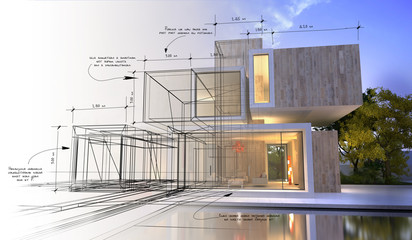Architecture has always been more than just the art of designing buildings. It is the harmonious blend of creativity, engineering, and functionality that shapes the spaces where people live, work, and gather. From ancient structures to modern skyscrapers, architecture reflects culture, innovation, and the needs of society. Understanding the principles of architecture helps us appreciate not only the beauty of design but also its role in improving the quality of life and sustainability.

The Essence of Architecture
At its core, architecture is about creating functional spaces that serve human needs while also appealing to aesthetics. It balances form and function, merging practicality with artistic expression. Good architecture ensures that a structure is safe, durable, and efficient while also being visually pleasing.
Whether it is a residential home, commercial building, or monumental landmark, every architectural design tells a story. It reflects cultural values, technological advancements, and the vision of its creators.
The Role of Architecture in Society
Architecture influences daily life in ways people often overlook. It affects how communities develop, how individuals interact, and how efficiently spaces are used. Well-designed architecture contributes to:
- Comfort and Livability – Residential architecture ensures safe, comfortable, and welcoming living spaces.
- Productivity – Office and commercial buildings designed with natural light, open layouts, and energy efficiency enhance productivity.
- Cultural Identity – Architectural styles often embody cultural values and traditions.
- Environmental Impact – Sustainable architecture minimizes energy use, reduces waste, and conserves resources.
- Urban Development – City planning and infrastructure design guide how societies grow and adapt over time.
Architecture is not just about buildings—it shapes the way people experience and interact with the world.
Principles of Good Architectural Design
While styles and trends change, some fundamental principles define quality architecture:
- Functionality – A design must serve its intended purpose. A home should provide comfort, an office should encourage productivity, and a public space should be accessible.
- Durability – Structures must withstand time, weather, and usage without compromising safety.
- Aesthetics – Beyond utility, architecture should inspire and appeal visually. The balance of symmetry, proportion, and creativity adds beauty to structures.
- Sustainability – Modern architecture emphasizes eco-friendly practices, using energy-efficient systems and renewable materials.
- Innovation – New technology and creative thinking push boundaries, offering unique designs that redefine spaces.
Styles of Architecture Through Time
Architecture has evolved through centuries, with each era leaving its mark on history. While trends shift, many classic and modern styles continue to influence design today:
- Classical Architecture – Known for symmetry, columns, and grandeur.
- Gothic Architecture – Famous for tall spires, intricate details, and stained glass.
- Modern Architecture – Characterized by minimalism, open spaces, and functional design.
- Postmodern Architecture – Combines playfulness and creativity with unconventional shapes.
- Sustainable Architecture – Focuses on energy efficiency, recycled materials, and harmony with the environment.
These styles demonstrate how architecture reflects societal changes and technological advancements.
The Importance of Sustainable Architecture
One of the most significant trends in modern architecture is sustainability. With growing awareness of environmental concerns, architects are now designing buildings that reduce energy use and environmental impact.
Sustainable architecture often includes features such as:
- Energy-efficient heating, cooling, and lighting systems
- Use of renewable or recycled building materials
- Incorporation of natural ventilation and daylight
- Green roofs and vertical gardens
- Smart technology to monitor energy consumption
These practices not only benefit the environment but also reduce long-term costs for building owners.
Architecture and Human Experience
The design of a building affects more than just its appearance—it influences how people feel and behave within it. Studies have shown that well-designed spaces can reduce stress, increase focus, and improve overall well-being.
For example:
- Natural light improves mood and reduces energy costs.
- Open spaces encourage collaboration and social interaction.
- Soundproofing creates peaceful environments in busy areas.
- Accessibility features ensure inclusivity for all individuals.
Architecture has the power to shape emotions and foster positive experiences in everyday life.
Challenges in Modern Architecture
While architecture continues to evolve, it also faces challenges that require innovative solutions:
- Urbanization – Growing populations demand efficient use of space in crowded cities.
- Climate Change – Rising temperatures and extreme weather require resilient building designs.
- Affordability – Architects must balance cost with functionality and aesthetics.
- Technology Integration – Incorporating smart systems while maintaining design balance is key.
Overcoming these challenges ensures that architecture continues to serve humanity effectively.
The Future of Architecture
The future of architecture is rooted in creativity, technology, and sustainability. Emerging trends suggest that buildings will become smarter, greener, and more adaptable. Some innovations shaping the future include:
- 3D Printing – Revolutionizing construction with faster, cost-effective building methods.
- Modular Design – Prefabricated structures that allow flexibility and scalability.
- Biophilic Design – Bringing nature into buildings to improve well-being and sustainability.
- Smart Buildings – Automated systems that adjust lighting, heating, and security for efficiency.
- Adaptive Reuse – Transforming old buildings into new functional spaces rather than demolishing them.
These advancements show that architecture will continue to evolve alongside human needs and technological growth.
Architecture is more than just the construction of buildings—it is an art form, a science, and a reflection of society’s values. From ancient landmarks to modern skyscrapers, it has shaped human history and continues to define the future. By combining creativity, functionality, and sustainability, architecture improves lives and ensures that spaces are not only practical but also inspiring.
As technology advances and environmental challenges grow, architecture will remain at the forefront of innovation, designing spaces that are efficient, sustainable, and deeply connected to human experience.